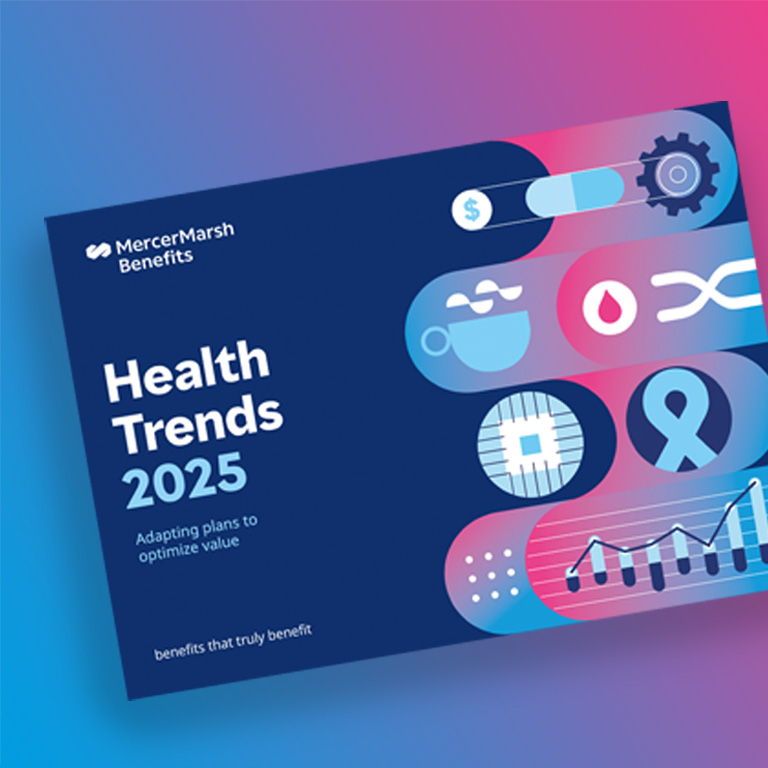
By Julio Garcia-Villalon ,
Mercer Marsh Benefits Leader
08/04/2022 · 4 minute read
These past few years have taken a toll on many businesses. The shift in the ways of working presented employers with many challenges, but also with opportunities to create a happier, healthier and more resilient workforce. Those organisations that rose to the challenge reaped the rewards. Employers who weren’t able to adequately prepare may have exposed their business to increased people risks and higher health and benefit costs.
To make sure that your business stays on top of health trends, costs and emerging risks, employers must take action. We recommend four key actions that employers can take now to prepare their business and their people for any challenges that may arise in the future.
Cost management is a priority, especially since 62% of insurers across the Middle East and Africa region are expecting claim costs to be higher in 2022 than they were during pre-pandemic levels and to continue increasing. With the expected benefit enhancements, regulatory changes and cost increases for this year, employers need to review their cost containment strategies and ensure that they align with current health trends, claims activity and medical trend rate increases. It’s vital to understand how your benefits are being utilised. Data and analytics can help employers drive utilisation to more cost effective providers.
With non-communicable diseases still ranking as one of the top factors that drive up claims in both cost and frequency, employers need to consider including preventative and self-care options into their benefit plans to help employees manage these chronic conditions and enable better lifestyles. Many insurers are now providing digital tools to help employees manage their health in a more proactive way, which can lead to a reduction in delayed treatment and healthier lifestyle. During lockdown, some employers in the United Arab Emirates offered their employees to take office equipment and use it at home in an effort to reduce the occurrence of musculoskeletal conditions. Employers need to embed the use of preventative care and self-care into their organisational culture and run regular employee communication to drive education and awareness. Employers should focus on enabling employees to see the value of their benefits and the positive impact they can have on their mental and physical health.
Medical costs are on the rise again, driven by increasing claims activity and a changing health and benefits landscape that is bringing about regulatory changes, enhancements to benefits, and changes in utilisation of benefits by employees. Understanding health trends and planning for them in your benefit plan design will ensure that employers are able to manage costs and risk more effectively. Here are a few considerations when designing your benefit plan:
Employers should also ensure that their benefit plans include a variety of mental health and well-being offerings that not only support employees who are sick but also support overall workforce health and wellness. In the Kingdom of Saudi Arabia, many employers enhanced their Employee Assistance Programs during the pandemic to include increased mental, physical and financial health support. Mercer Marsh Benefits global survey on Health Trends (2021) showed that 70% of insurers reported to offer telemedicine services for simple health issues like a rash or common cold, and many medical schemes in South Africa saw an overall increase in the use of wellness offerings during the pandemic.
Data can help employers improve the health of their workforce by showing the value that their health and benefits plan actually provides to the employees. Employers are then able to use the data to improve overall plan design and to drive utilisation toward benefits that will have a positive impact on the mental and physical health of their employees. Data can also be used to manage cost and mitigate people risk by using key analytics components such as in-depth claims analysis, benchmarking and predictive modelling tools. Insurers who participated in the global survey indicated that data and analytics was a top strategic priority for group medical insurance (34%), closely followed by provider management (21%) and quality care-focused benefit design (20%). These strategic priorities reflect the shift in health and benefits and that insurers and employers are considering changing workforces in their benefit plan design.
While the year ahead seems to bring with it numerous challenges, the opportunity for employers to embrace the changes and improve upon current practices and standards shows a positive outlook. Employers that take action now and implement a health and benefit strategy that balances cost but also provides employees with benefits they will value, seize the chance to create healthy and resilient people and a healthy and resilient business.

Article
13/10/2024